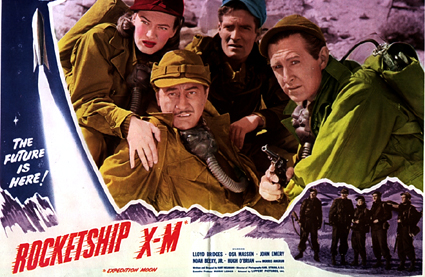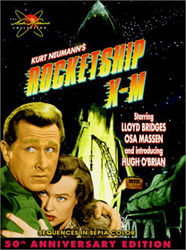| Release List | Reviews | Price Search | Shop | Newsletter | Forum | DVD Giveaways | Blu-Ray/ HD DVD | Advertise |
| Reviews & Columns |
|
Reviews DVD TV on DVD Blu-ray International DVDs Theatrical Reviews by Studio Video Games Features Collector Series DVDs Easter Egg Database Interviews DVD Talk TV DVD Talk Radio Feature Articles Columns Anime Talk DVD Savant HD Talk Horror DVDs Silent DVD
|
DVD Talk Forum |
|
|
| Resources |
|
DVD Price Search Customer Service #'s RCE Info Links |
|
Columns
|
 |
ROCKETSHIP X-M
|
||||
As pointed out by notables such as Joe Dante, the first wave of 50s Science Fiction films were largely big-studio "A" pictures investigating the potential appeal of the newfound genre. The famous classics Day the Earth Stood Still, The Thing from Another World, When Worlds Collide, It Came From Outer Space -- all sought to capitalize on a vein struck by a pair of independent 1950 productions about space travel that premiered within weeks of one another. Destination Moon was in Technicolor, got all the press and had the blessing of the scientific establishment for its nigh-flawless accuracy. The other film, Rocketship X-M, was a B&W upstart with a fraction of George Pal's budget ($94,000 to Moon's $600,000) and no coherent scientific basis whatsoever. Yet X-M is Moon's equal in entertainment value: Far superior as a drama and just as interesting when discussing the Science Fiction boom the two of them inaugurated. Savant's Destination Moon review stressed its unusually conservative roots: From a reactionary book by Robert Heinlein, it carried a definite Cold War pedigree. Rocketship X-M was revealed a few years ago to have been written by the blacklisted Dalton Trumbo, the populist writer of sentimental and patriotic wartime hits like Tender Comrade and A Guy Named Joe. An accused Communist sympathizer whose screenplays consistently extolled the virtues of Democratic principles, the exiled Trumbo seems to have written some of the 50s most interesting scripts. Synopsis: Dr. Karl Eckstrom (John Emory) and his flight crew hold a press conference a few minutes before the takeoff of their Moon mission spaceship, the X-M (for eXpedtion Moon). On the way we meet his crew: The lovely mathematician Lisa Van Horn (Osa Massen), Colonel Floyd Graham (Lloyd Bridges), nervous navigator Harry Chamberlin (Hugh O'Brien) and flight engineer Bill Corrigan (Noah Beery, Jr.), a drawling Texan. Narrowly missed by some passing meteorites and 'stalled' in space while Eckstrom and Van Horn recalculate the fuel mixture, the crew passes out while in acceleration. When they wake up they find themselves hundreds of millions of miles off course and gaping through their rocketship portholes at the planet Mars. Seizing the opportunity, the astronauts explore the desert-like planet with oxygen masks and guns, and discover the ruins of an irradiated city. An advanced civilization seems to have annihilated itself in a nuclear conflagration. They have time to glimpse only a couple of artifacts before retreating in the face of climbing radiation levels. While they rest in a gully, humanoid shapes approach from out of the canyon walls ... The experts sometimes split 50s Science Fiction films into the right wing, conservative variety (The Thing, When Worlds Collide, War of the Worlds, Them!,) and a much shorter list of leftist, pacifist counterparts: The Day The Earth Stood Still, The Man From Planet X, and It Came From Outer Space. Trumbo makes Rocketship X-M the very first of the pacifist variety. There's the expected mention of moon-based rockets being an essential goal of any power seeking to dominate the Earth militarily. But Trumbo, while providing us with his usual obvious types (soft-hearted Texan, anti-emotional scientist, female scientist who really wants to get married and have kids) also manages to get in a number of speeches about the hazards of nuclear war. It needs to be remembered that in 1950 there was nothing in popular culture that opposed the AEC's pro-nuke position on Atomic Power. Whereas the same year's D.O.A. clearly hid its radiation-poisoning theme by calling it 'luminous poisoning', Rocketship X-M had the nerve to show a Geiger counter hitting the red zone. The investigation of the Martian ruins is cut short because it's unsafe to hang around such a high roentgen count. In the year that conscience-stricken nuclear scientist Robert Oppenheimer was having his career chopped off at the knees just for saying negative things about the Bomb, Trumbo reached millions of American children with his equally 'anti-American' speeches about nuclear folly. The blacklist turned a cheerleader for patriotism into a cheerful subversive, not of America but of its creeping militaristic blindness. Rocketship X-M's Martian martyrs deliver the message that nuclear war could destroy our civilization, just as the noble characters in Trumbo's WW2 movies talked about a better world after the armistice. Forever the idealist, for Trumbo personal problems and even death are never as important as humanitarian values. 
(spoiler:) Kids who saw Rocketship X-M on television in the late 50s took it pretty seriously. Hey, everybody died, and Mike Nelson from Sea Hunt died smiling (sort of), hugging the woman he loved in a substitute sexual climax that paid off like the end of White Heat: "Made it Ma! That's one giant leap for mank --" Boom!)Here was an appealing altruistic doom, like Wake Island or The Alamo, only with spaceships. Rocketship X-M came even before David Lean's Breaking the Sound Barrier, with its weird moral that equates Progress with a suicidal eagerness to die testing new aircraft and new inventions. Doctor Ralph Fleming (Morris Ankrum) learns of the total loss of his mission and immediately announces the beginning of the X-M 2 project. We 50s kids were therefore fully indoctrinated with the idea that space exploration was a Holy Quest that must continue, no matter what: NASA budget cuts and cold feet after the Challenger space shuttle disaster seemed unthinkable to us fans who firmly believed the messages of Rocketship X-M and Things to Come. Although a lot of the banter (particularly Lloyd Bridges' smug insistence that Osa Massen quit her slide rule and get serious about nesting) dates fairly badly, there's nothing in Rocketship X-M as dumb as the cornball Dick Wesson of Destination Moon. The straightforward plot introduces the characters, they go into space, talk briefly about the new planet they explore and are quickly wiped out. Unlike the cardboard heroes of the Pal film, we care about these imperfect types wandering the desert of Mars, and their deaths have a sting of futility. The best America has to offer are being massacred by stone-age cavemen ... something's wrong with this picture. Massen and Bridges' final pledge of love as the X-M plummets into the Earth's atmosphere was almost traumatic - for kids who would never sit through Wuthering Heights, this all seemed incredibly important. The science of Rocketship X-M is beyond all hope, and provides endless hilarity for the MST3K roast of the film. If there were a science advisor on the production, someone left him bound and gagged in the corner. Unlike Moon, every known rule about space travel is broken. Meteors whistle loudly by in the vacuum of space. One slip of the accelerators and the ship misses the Moon, somehow arriving in Mars orbit only a few hours later. En route, the scientists work out petty details like fuel mixtures, that should have been part of basic R&D way before a rocket was built. They decide on their basic strategy for the Mars landing almost as an afterthought. Although unsurprised when their limited fuel takes them all the way to Mars, the survivors are shocked when their tanks run dry just as they return home. Today's average junior high student who stays awake in science class isn't going to be fooled for a moment. But in 1950, Rocketship X-M's boffo boxoffice was the first proof that Science Fiction success wasn't dependent on scientific accuracy. The remainder of the decade would be dominated by inane Z pictures like Cat-Women of the Moon. With the exception of the George Pal washout Conquest of Space, kids would have to wait until the 60s to see the subject attempted with both seriousness and high production values, in films like Robinson Crusoe on Mars and First Men IN the Moon. Rocketship X-M was produced by Lippert films, one of the cheapest outfits in Hollywood. Yet most of its production values were good. The rocket interior set is impressive and the sepia-toned Mars exteriors were shot on location at Red Rock Canyon (familiar from the Westerns The Big Country and Man of the West) and maybe even Death Valley. Perhaps the biggest production coup was signing Ferde Grofe, the famous composer known for his Grand Canyon Suite, for the score. The romantic themes are just adequate but his theremin-loaded Mars exploration music is very impressive in its weird bleakness. Director Kurt Neumann was an unfussy journeyman who turned out a steady stream of low budget product in the 50s. His Science Fiction films were all filmed by Karl Struss and included the delirious Kronos and the gory The Fly, completed just before his death. Neumann's She Devil was a RegalScope production co-billed with Kronos that nobody seems to have rediscovered -- its unintentional ridiculousness masks a plot so misogynistic it could stop a feminist revisionist's heart at twenty paces. The one negative about Rocketship X-M is that meddling entrepreneur Wade Williams took it upon himself to have some of the Cascade group of special effects experts shoot replacements for a few of the less-than convincing original effects. If Savant recalls correctly, mis-matching V-2 rocket shots were used for the Mars landing scene. Williams hired a young Dennis Muren (almost immediately previous to his work on Star Wars) and others to film the new shots, and they look fine. We thought that Williams obliterated the original version, but most of the shots here appear to be the originals. At least Williams didn't massacre X-M the way he did Invaders from Mars, a decent copy of which doesn't even seem to exist anymore. Image Entertainment's DVD of Rocketship X-M is made from great elements. The audio is almost perfect, with some intermittent light distortion. The picture has a scratch here and there but otherwise is mint. The sepia-toned Mars sequence looks more orange than sepia brown, as if timed to match video copies of The Angry Red Planet. It still looks fine; the matte painting sequence with the domed ruins in the background is particularly good. Collectors are going to want this one. There aren't many 50s Sci Fi efforts that succeed as romantic melodramas, and Rocketship X-M consistently wins the approval of 'civilians.'
On a scale of Excellent, Good, Fair, and Poor, Rocketship X-M rates:
Review Staff | About DVD Talk | Newsletter Subscribe | Join DVD Talk Forum |
|
| Release List | Reviews | Price Search | Shop | SUBSCRIBE | Forum | DVD Giveaways | Blu-Ray/ HD DVD | Advertise |






